Last week we were in Italy again (-: . The weather was great, the food as delicious as always and we spent many hours visiting museums, churches and other interesting sites. There is a whole list of things to talk about: The Uffizi in Florence, the national museum of medieval art San Matteo in Pisa, the little mountain town of Barga with its wonderful church, the Devil’s Bridge near Lucca, the Duomo in Lucca, the list goes on. Of all things worthy to share one subject stands out: the convent of San Marco in Florence. Why, you ask? The amazing frescoes by Fra Angelico for one thing and its link to Girolamo Savonarola, reformer and heretic who eventually was tortured and hanged for his alleged crimes in the main square of Florence.
San Marco
The San Marco church and convent is now a museum. I have visited Florence five or six times and yet this was my first visit to the San Marco museum. The reason for this has partly to do with its location, it is slightly out of the way in the northern part of the inner city and in addition to this it probably is a typical place to visit after you have seen all the main attractions. Nevertheless it is a real gem for its art and place in history. The convent we see today is basically unaltered since it was build in 1437 on a site of an earlier church. The new complex was occupied by the Dominican order and sponsored by Lorenzo di Medici, who had a personal cell here to retreat into.
Fra Angelico
Fra Angelico lived in this convent from 1436–1445 and during this time he painted many frescoes on the walls of the convent. What is special about these frescoes is their intended audience and effect. Mostly frescoes and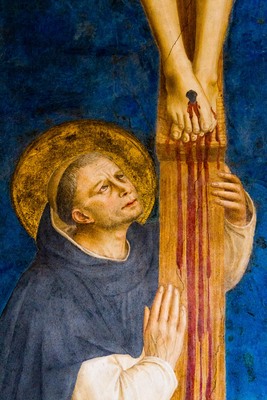 paintings were meant to educate the general public about the Holy Scriptures. The frescoes Fra Angelico painted in this convent were meant to be seen only by the friars living there. These friars were literate and were very well aware of the stories in the bible. Fra Angelico painted these meditational frescoes with the specific purpose of evoking spiritual energy, thus assisting the friars in solitary payer and contemplation. In today's terms we would say that these frescoes show and evoke real human emotion. Please take a close look at the face of the Dominican friar in the picture to the right (Click image for a larger version in a separate window). And it is just that what is so special in a work of art from 1445, heralding the coming of a new age: The Renaissance. Put in yet another way: Fra Angelico realized the advancements made by Masaccio in the Brancacci Chapel and carried them further. Today, most works of art can only be seen out of their original context in a distant museum. The fact that these frescoes are still in their original places in the convent for which they were made makes them doubly special. There are not many places on Earth were you can see so much great art in its original unaltered context.
paintings were meant to educate the general public about the Holy Scriptures. The frescoes Fra Angelico painted in this convent were meant to be seen only by the friars living there. These friars were literate and were very well aware of the stories in the bible. Fra Angelico painted these meditational frescoes with the specific purpose of evoking spiritual energy, thus assisting the friars in solitary payer and contemplation. In today's terms we would say that these frescoes show and evoke real human emotion. Please take a close look at the face of the Dominican friar in the picture to the right (Click image for a larger version in a separate window). And it is just that what is so special in a work of art from 1445, heralding the coming of a new age: The Renaissance. Put in yet another way: Fra Angelico realized the advancements made by Masaccio in the Brancacci Chapel and carried them further. Today, most works of art can only be seen out of their original context in a distant museum. The fact that these frescoes are still in their original places in the convent for which they were made makes them doubly special. There are not many places on Earth were you can see so much great art in its original unaltered context.
Girolamo Savonarola
Another famous inhabitant of this convent was Girolamo Savonarola. In fact he occupied Fra Angelico's cell from 1482 till his public hanging in the main square of Florence in 1498. I had read about this preacher, reformer, hertic before, but I had never really understood his significance till now. From an early age (as we know from letters to his father) he was appalled by the hypocracy of the clergy. Today we would call him a Puritan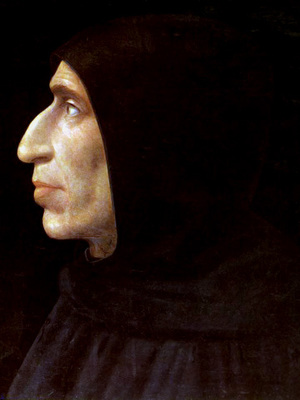 . He found his calling as a preacher when he impressed the public with his message that the Church had to change its corrupt ways. People were outright scared when he correctly predicted that a "Powerful Sword of the Lord from the North" (King Charles VIII of France) would invade Italy and threaten Florence. The good citizens of Florence quickly austed their rulers, the di Medici's, and after that Savonarola convinced the French to bypass Florence all together and go after the real culprit instead: the Pope in Rome. For a short while Savonarola ran the city of Florence as a democratic theocracy. Depending on who's writing the account this was a paradise on earth, a haven of democracy in a corrupt world or sheer maddness reaching a climax in the carnival of 1497 where Savonarola organized troops of boys and girls to tour the city, house to house, and begged the people to give up their gauds and vanities, from cosmetics to pagan books and paintings, the worldly things that turned their hearts away from true Christian living. And soon in the great square of Florence rose a great pyramid, fifteen stories high, carnival masks, rich dresses women's ornaments, wigs, mirrors, powder puffs, rouge-pots, lip-sticks, cards and dice, perfume and cosmetics, books of poems and on magic, musical instruments, trinkets of all kinds and worldly paintings in which Greek nymphs displayed their unclothed shapes. When Savonarola attacked Pope Alexander VI directly, accusing him of debauchery, he took on an enemy too powerful to mess with. You might recognize the name of Pope Alexander VI and if you are wondering why it is because you know him from the TV series The Borgias. Yes, it is the very same Pope. The Pope excommunicated Savonarola (this did not bother him much) and threatened the Florentines with an interdict. This interdict meant in effect a trade embargo for the city of Florence. So Savonarola all of a sudden became a lot less popular with the good citizens of Florence. They forced him to shut up. But Savonarola was no the man to be shut up for long,
. He found his calling as a preacher when he impressed the public with his message that the Church had to change its corrupt ways. People were outright scared when he correctly predicted that a "Powerful Sword of the Lord from the North" (King Charles VIII of France) would invade Italy and threaten Florence. The good citizens of Florence quickly austed their rulers, the di Medici's, and after that Savonarola convinced the French to bypass Florence all together and go after the real culprit instead: the Pope in Rome. For a short while Savonarola ran the city of Florence as a democratic theocracy. Depending on who's writing the account this was a paradise on earth, a haven of democracy in a corrupt world or sheer maddness reaching a climax in the carnival of 1497 where Savonarola organized troops of boys and girls to tour the city, house to house, and begged the people to give up their gauds and vanities, from cosmetics to pagan books and paintings, the worldly things that turned their hearts away from true Christian living. And soon in the great square of Florence rose a great pyramid, fifteen stories high, carnival masks, rich dresses women's ornaments, wigs, mirrors, powder puffs, rouge-pots, lip-sticks, cards and dice, perfume and cosmetics, books of poems and on magic, musical instruments, trinkets of all kinds and worldly paintings in which Greek nymphs displayed their unclothed shapes. When Savonarola attacked Pope Alexander VI directly, accusing him of debauchery, he took on an enemy too powerful to mess with. You might recognize the name of Pope Alexander VI and if you are wondering why it is because you know him from the TV series The Borgias. Yes, it is the very same Pope. The Pope excommunicated Savonarola (this did not bother him much) and threatened the Florentines with an interdict. This interdict meant in effect a trade embargo for the city of Florence. So Savonarola all of a sudden became a lot less popular with the good citizens of Florence. They forced him to shut up. But Savonarola was no the man to be shut up for long, 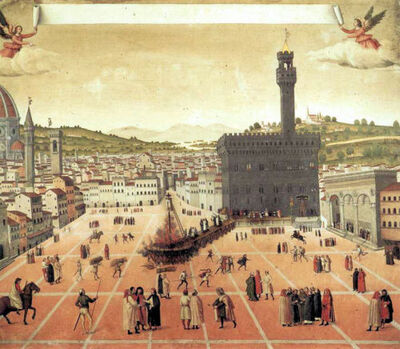 he persisted in his ways preaching puritanism and calling for church reforms. Savonarola hinted at performing miracles to prove his divine mission, but when a rival Franciscan preacher proposed to test that mission by walking through fire, he lost control of the public discourse. Without consulting him, his confidant fra Domenico da Pescia offered himself as his surrogate and Savonarola felt he could not afford to refuse. A crowd filled the central square, eager to see if God would intervene and if so, on which side. The nervous contestants and their delegations delayed the start of the contest for hours. A sudden rain drenched the spectators and government officials cancelled the proceedings. The crowd disbanded angrily; the burden of proof had been on Savonarola and he was blamed for the fiasco. A mob assaulted the convent of San Marco. Savonarola and two friends were arrested and imprisoned. Under torture Savonarola confessed to having invented his prophecies and visions, then retracted, then confessed again. On the morning of May 23, 1498, the three friars were led out into the main square where, before a tribunal of high clerics and government officials, they were condemned as heretics and schismatics, and sentenced to die forthwith. Stripped of their Dominican garments in ritual degradation, they mounted the scaffold in their thin white shirts. Each on a separate gallows, they were hanged, while a fire was ignited below them to consume their bodies. There is a painting in the San Marco museum depicting this very scene, although not very realistically, because we know from written accounts the square was crowded with people both cheering and crying. Click on the picture to the right to open a larger version in a separate window.
he persisted in his ways preaching puritanism and calling for church reforms. Savonarola hinted at performing miracles to prove his divine mission, but when a rival Franciscan preacher proposed to test that mission by walking through fire, he lost control of the public discourse. Without consulting him, his confidant fra Domenico da Pescia offered himself as his surrogate and Savonarola felt he could not afford to refuse. A crowd filled the central square, eager to see if God would intervene and if so, on which side. The nervous contestants and their delegations delayed the start of the contest for hours. A sudden rain drenched the spectators and government officials cancelled the proceedings. The crowd disbanded angrily; the burden of proof had been on Savonarola and he was blamed for the fiasco. A mob assaulted the convent of San Marco. Savonarola and two friends were arrested and imprisoned. Under torture Savonarola confessed to having invented his prophecies and visions, then retracted, then confessed again. On the morning of May 23, 1498, the three friars were led out into the main square where, before a tribunal of high clerics and government officials, they were condemned as heretics and schismatics, and sentenced to die forthwith. Stripped of their Dominican garments in ritual degradation, they mounted the scaffold in their thin white shirts. Each on a separate gallows, they were hanged, while a fire was ignited below them to consume their bodies. There is a painting in the San Marco museum depicting this very scene, although not very realistically, because we know from written accounts the square was crowded with people both cheering and crying. Click on the picture to the right to open a larger version in a separate window.
Opinions
The Britannica online encyclopedia considers Savonarola a forerunner of Luther and mentions that in Worms, Germany Savonarola has a statue besides the statue of Martin Luther himself. The Catholic online encyclopedia mentions that the Pope had been very lenient and finally had to act against Savonarola to prevent a schism in the Roman Catholic Church. The statue in Worms is totally unwarranted in their view. Finally Machiavelli wrote in the Prince:"If Moses, Cyrus, Theseus, and Romulus had been unarmed they could not have enforced their constitutions for long — as happened in our time to Fra Girolamo Savonarola, who was ruined with his new order of things immediately the multitude believed in him no longer, and he had no means of keeping steadfast those who believed or of making the unbelievers to believe."
In 1982 Pope John Paul II beatified Fra Angelico and 1984 declared him patron of Catholic artists. It seems unlikely that Savonarola, Fra angelico's "cellmate" in the convent of San Marco, will be bestowed the same honor any time soon ...
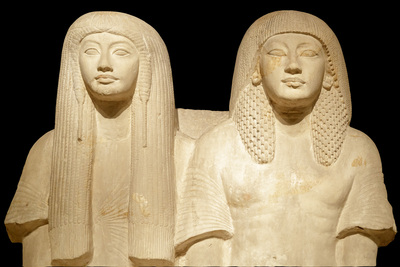 For more than a decade now, I shoot photos of ancient art in museums around the world. A particular favorite of mine is ancient Egyptian art. At the start of 2016 I have about 1400 photos of Egyptian art. In 2002, I started out with a simple Sony digital point-and-shoot camera, but more recently I use a professional Canon digital single reflex camera. You can take a look at the gear section (link opens in a new window) of this blog, if you are interested in the photography part.This ancient art gallery (link opens in a new window) contains a selection of these photos in chronological order of date taken. For the time being this gallery contains ancient Egyptian and ancient Greek art photos. In a few cases, when photography is not allowed in a particular museum, I have resorted to using scans. This is very unfortunate. I have tried to correctly identify all works of art in the captions using various sources. Firstly, in recent years I always take an additional photo of the label and enter this text in the caption.
For more than a decade now, I shoot photos of ancient art in museums around the world. A particular favorite of mine is ancient Egyptian art. At the start of 2016 I have about 1400 photos of Egyptian art. In 2002, I started out with a simple Sony digital point-and-shoot camera, but more recently I use a professional Canon digital single reflex camera. You can take a look at the gear section (link opens in a new window) of this blog, if you are interested in the photography part.This ancient art gallery (link opens in a new window) contains a selection of these photos in chronological order of date taken. For the time being this gallery contains ancient Egyptian and ancient Greek art photos. In a few cases, when photography is not allowed in a particular museum, I have resorted to using scans. This is very unfortunate. I have tried to correctly identify all works of art in the captions using various sources. Firstly, in recent years I always take an additional photo of the label and enter this text in the caption. 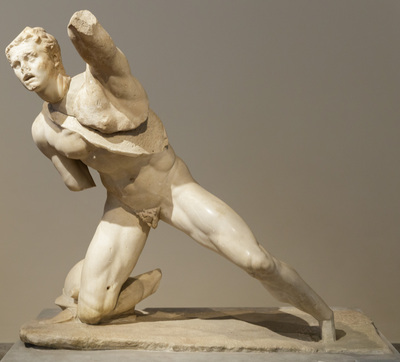 If a label is not available, or if I forget to shoot the label, I use art books, Wikipedia and Google. Sometimes it takes a considerable amount of time to identify a particular work of art. This form of treasure hunting is part of the fun! If things work correctly you will be able to land on the right photo page using an appropriate Google search for the work of art you are interested in. If I have it, that is. The plan is to extend this gallery with other ancient art (Byzantine and Roman) over time.
If a label is not available, or if I forget to shoot the label, I use art books, Wikipedia and Google. Sometimes it takes a considerable amount of time to identify a particular work of art. This form of treasure hunting is part of the fun! If things work correctly you will be able to land on the right photo page using an appropriate Google search for the work of art you are interested in. If I have it, that is. The plan is to extend this gallery with other ancient art (Byzantine and Roman) over time.
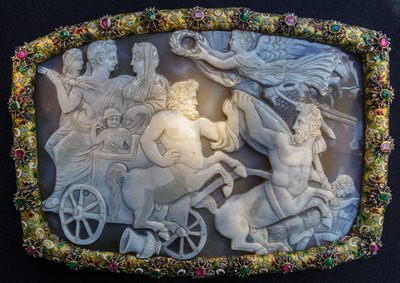
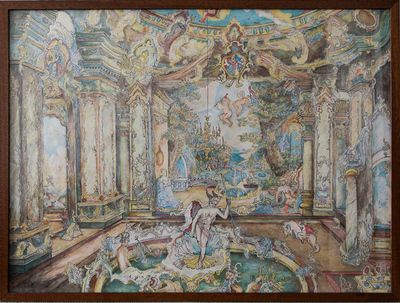
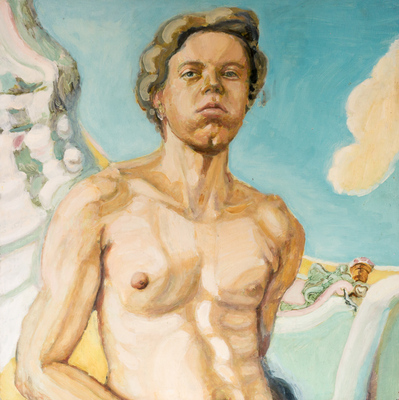
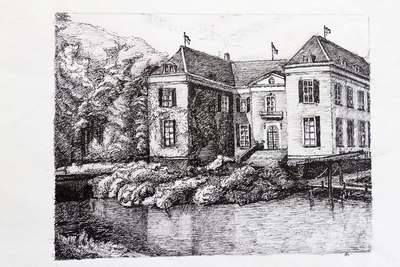
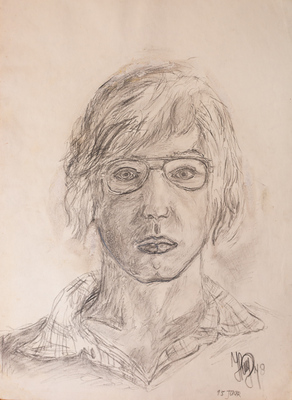
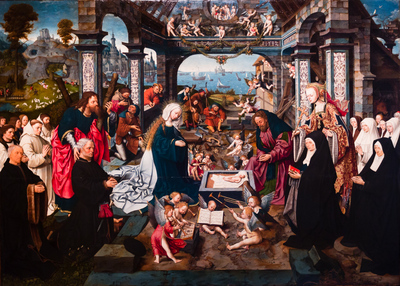
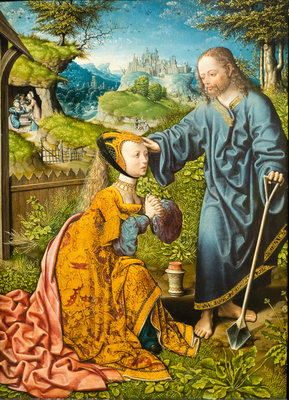
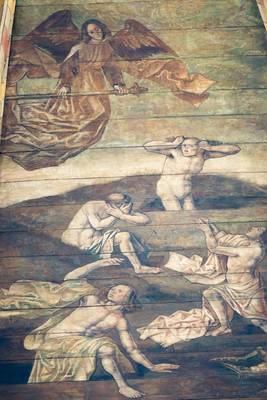
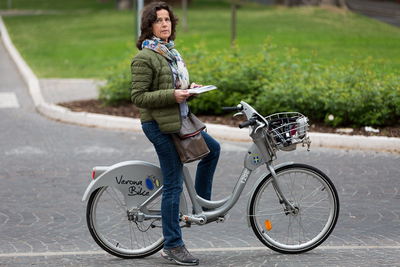
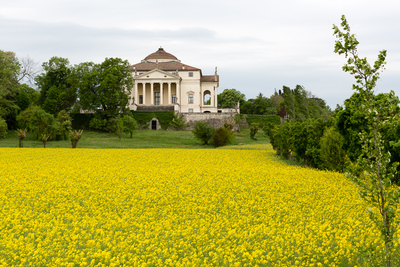




 . He found his calling as a preacher when he impressed the public with his message that the Church had to change its corrupt ways. People were outright scared when he correctly predicted that a "Powerful Sword of the Lord from the North" (King Charles VIII of France) would invade Italy and threaten Florence. The good citizens of Florence quickly austed their rulers, the di Medici's, and after that Savonarola convinced the French to bypass Florence all together and go after the real culprit instead: the Pope in Rome. For a short while Savonarola ran the city of Florence as a democratic theocracy. Depending on who's writing the account this was a paradise on earth, a haven of democracy in a corrupt world or sheer maddness reaching a climax in the carnival of 1497 where Savonarola organized troops of boys and girls to tour the city, house to house, and begged the people to give up their gauds and vanities, from cosmetics to pagan books and paintings, the worldly things that turned their hearts away from true Christian living. And soon in the great square of Florence rose a great pyramid, fifteen stories high, carnival masks, rich dresses women's ornaments, wigs, mirrors, powder puffs, rouge-pots, lip-sticks, cards and dice, perfume and cosmetics, books of poems and on magic, musical instruments, trinkets of all kinds and worldly paintings in which Greek nymphs displayed their unclothed shapes. When Savonarola attacked Pope Alexander VI directly, accusing him of debauchery, he took on an enemy too powerful to mess with. You might recognize the name of Pope Alexander VI and if you are wondering why it is because you know him from the TV series The Borgias. Yes, it is the very same Pope. The Pope excommunicated Savonarola (this did not bother him much) and threatened the Florentines with an interdict. This interdict meant in effect a trade embargo for the city of Florence. So Savonarola all of a sudden became a lot less popular with the good citizens of Florence. They forced him to shut up. But Savonarola was no the man to be shut up for long,
. He found his calling as a preacher when he impressed the public with his message that the Church had to change its corrupt ways. People were outright scared when he correctly predicted that a "Powerful Sword of the Lord from the North" (King Charles VIII of France) would invade Italy and threaten Florence. The good citizens of Florence quickly austed their rulers, the di Medici's, and after that Savonarola convinced the French to bypass Florence all together and go after the real culprit instead: the Pope in Rome. For a short while Savonarola ran the city of Florence as a democratic theocracy. Depending on who's writing the account this was a paradise on earth, a haven of democracy in a corrupt world or sheer maddness reaching a climax in the carnival of 1497 where Savonarola organized troops of boys and girls to tour the city, house to house, and begged the people to give up their gauds and vanities, from cosmetics to pagan books and paintings, the worldly things that turned their hearts away from true Christian living. And soon in the great square of Florence rose a great pyramid, fifteen stories high, carnival masks, rich dresses women's ornaments, wigs, mirrors, powder puffs, rouge-pots, lip-sticks, cards and dice, perfume and cosmetics, books of poems and on magic, musical instruments, trinkets of all kinds and worldly paintings in which Greek nymphs displayed their unclothed shapes. When Savonarola attacked Pope Alexander VI directly, accusing him of debauchery, he took on an enemy too powerful to mess with. You might recognize the name of Pope Alexander VI and if you are wondering why it is because you know him from the TV series The Borgias. Yes, it is the very same Pope. The Pope excommunicated Savonarola (this did not bother him much) and threatened the Florentines with an interdict. This interdict meant in effect a trade embargo for the city of Florence. So Savonarola all of a sudden became a lot less popular with the good citizens of Florence. They forced him to shut up. But Savonarola was no the man to be shut up for long, 
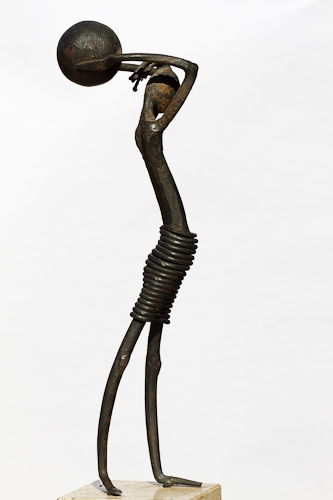 specifically they paid the art library's fee so that we could keep the statue for one year. For two years in a row we renewed this arrangement, because we really like it. This year they did not let us renew it again, so we bought it. I have googled the artist, but apart from a few old newspaper clippings, I did not find much. One of these clippings was an article "Metaal- en glaskunst van Jean v.d. Poll" dated October 3rd 1967 in "Utrechts Nieuwsblad". Apparently Jean van der Poll held an exhibition in Bilthoven around that date. The art critic mentions an object he calls "girl with ball". This has to be our girl! The art library has another sculpture by the same artist. Presently someone else has this work, but we have already reserved it.
specifically they paid the art library's fee so that we could keep the statue for one year. For two years in a row we renewed this arrangement, because we really like it. This year they did not let us renew it again, so we bought it. I have googled the artist, but apart from a few old newspaper clippings, I did not find much. One of these clippings was an article "Metaal- en glaskunst van Jean v.d. Poll" dated October 3rd 1967 in "Utrechts Nieuwsblad". Apparently Jean van der Poll held an exhibition in Bilthoven around that date. The art critic mentions an object he calls "girl with ball". This has to be our girl! The art library has another sculpture by the same artist. Presently someone else has this work, but we have already reserved it.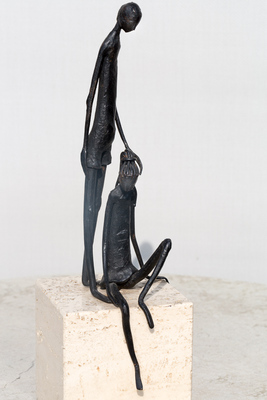
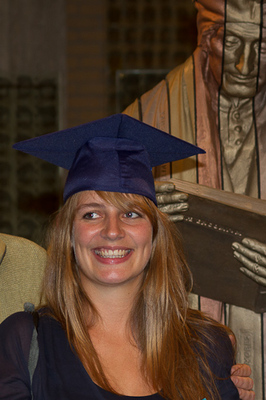 In this Master thesis Lisa explores the reasons for popular music venues in the Netherlands to (not) enter into strategic alliances with other cultural organizations. It is a qualitative study using semi-structured interviews to collect data. Lisa interviewed ten bookers/directors of some of the larger Dutch popular music venues. Here are some of the conclusions from the final chapter: "From the participants’ responses, it becomes clear that there are some major developments in the music industry. Most important developments are the growth of the Internet and globalization. The Internet causes audiences to become fragmented into smaller segments of visitors for larger segments of genres. Due to globalization, artists do fewer shows in The Netherlands. Participants consider experience an important theme, both for the audience as well for the artist. By booking at different locations, venues anticipate these changes. According to the researcher, this trend seems part of a bigger development. The interest of the city becomes an increasingly important factor in these partnerships on level of content. The researcher notices a shift in the function of the booker to some sort of promoter who divides the artists over the city depending on which location suits best. While participants are hesitant in their predictions, the researcher sees it as a step towards more cooperation." We are all very proud of her accomplishments!
In this Master thesis Lisa explores the reasons for popular music venues in the Netherlands to (not) enter into strategic alliances with other cultural organizations. It is a qualitative study using semi-structured interviews to collect data. Lisa interviewed ten bookers/directors of some of the larger Dutch popular music venues. Here are some of the conclusions from the final chapter: "From the participants’ responses, it becomes clear that there are some major developments in the music industry. Most important developments are the growth of the Internet and globalization. The Internet causes audiences to become fragmented into smaller segments of visitors for larger segments of genres. Due to globalization, artists do fewer shows in The Netherlands. Participants consider experience an important theme, both for the audience as well for the artist. By booking at different locations, venues anticipate these changes. According to the researcher, this trend seems part of a bigger development. The interest of the city becomes an increasingly important factor in these partnerships on level of content. The researcher notices a shift in the function of the booker to some sort of promoter who divides the artists over the city depending on which location suits best. While participants are hesitant in their predictions, the researcher sees it as a step towards more cooperation." We are all very proud of her accomplishments! 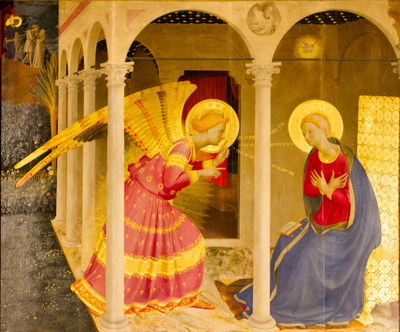
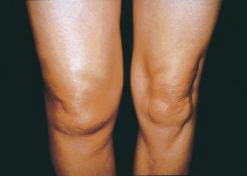 is my wife.
is my wife.

